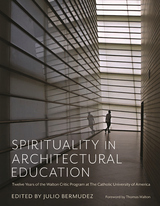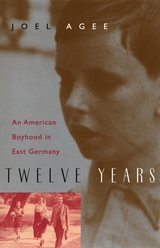2 books about Twelve Years

Spirituality in Architectural Education
Twelve Years of the Walton Critic Program at The Catholic University of America
Julio Bermudez
Catholic University of America Press, 2021
How does spirituality enter the education of an architect? Should it? What do we mean by ‘spirituality’ in the first place? Isn’t architectural education a training ground for professional practice and, therefore, technically and secularly oriented? Is there even room to add something as esoteric if not controversial as spirituality to an already packed university curriculum? The humanistic and artistic roots of architecture certainly invite us to consider dimensions well beyond the instrumental, including spirituality. But how would we teach such a thing? And why, if spirituality is indeed relevant to learning architecture, have we heard so little about it?
Spirituality in Architectural Education addresses these and many other important philosophical, disciplinary, pedagogic, and practical questions. Grounded on the twelve-year-old Walton Critic Program at the Catholic University of America School of Architecture and Planning, this book offers solid arguments and insightful reflections on the role that “big questions” and spiritual sensibility ought to play in the architectural academy today. Using 11 design studios as stopping grounds, the volume takes the reader into a journey full of meaningful interrogations, pedagogic techniques, challenging realizations, and beautiful designs. Essays from renowned architects Craig W. Hartman, Juhani Pallasmaa, Alberto Campo Baeza, Claudio Silvestrin, Eliana Bórmida, Michael J. Crosbie, Prem Chandavarkar, Rick Joy, Susan Jones, and Daniel Libeskind open new vistas on the impact of spirituality in architectural education and practice. All this work is contextualized within the ongoing discussion of the role of spirituality and religion in higher education at large. The result is an unprecedented volume that starts a long-awaited conversation that will advance architectural schooling. ACSA Distinguished Professor Julio Bermudez, with recognized expertise on spirituality in architecture, will be the guide in this fascinating and contemplative journey.
[more]

Twelve Years
An American Boyhood in East Germany
Joel Agee
University of Chicago Press, 2000
Joel Agee, the son of James Agee, was raised for twelve years in East Germany, where his stepfather, the novelist Bodo Uhse, was a member of the privileged communist intelligentsia. This is the story of how young Joel failed to become a good communist, becoming instead a fine writer.
"A wonderfully evocative memoir. . . . Agee evoked for me the atmosphere of postwar Berlin more vividly than the actual experience of it—and I was there." —Christopher Lehmann-Haupt, New York Times
"One of those rare personal memoirs that brings to life a whole country and an epoch." —Christopher Isherwood
"Twelve Years consists of a series of finely honed anecdotes written in a precise, supple prose rich with sensual detail." —David Ghitelman, Newsday
"By turns poetic and picturesque, Agee energetically catalogues his expatriate passage to manhood with a pinpoint eye and a healthy American distaste for pretension. . . . Huckleberry Finn would have . . . welcomed [him] as a soulmate on the raft." —J. D. Reed, Time
"A triumph. . . . Unfettered by petty analysis or quick explanations, a story that is timeless and ageless and vital." —Robert Michael Green, Baltimore Sun
"A wonderfully evocative memoir. . . . Agee evoked for me the atmosphere of postwar Berlin more vividly than the actual experience of it—and I was there." —Christopher Lehmann-Haupt, New York Times
"One of those rare personal memoirs that brings to life a whole country and an epoch." —Christopher Isherwood
"Twelve Years consists of a series of finely honed anecdotes written in a precise, supple prose rich with sensual detail." —David Ghitelman, Newsday
"By turns poetic and picturesque, Agee energetically catalogues his expatriate passage to manhood with a pinpoint eye and a healthy American distaste for pretension. . . . Huckleberry Finn would have . . . welcomed [him] as a soulmate on the raft." —J. D. Reed, Time
"A triumph. . . . Unfettered by petty analysis or quick explanations, a story that is timeless and ageless and vital." —Robert Michael Green, Baltimore Sun
[more]
READERS
Browse our collection.
PUBLISHERS
See BiblioVault's publisher services.
STUDENT SERVICES
Files for college accessibility offices.
UChicago Accessibility Resources
home | accessibility | search | about | contact us
BiblioVault ® 2001 - 2024
The University of Chicago Press









